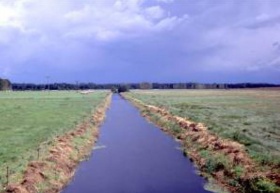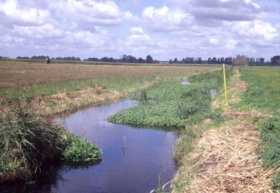Modify aquatic vegetation maintenance
Contents
- 1 Modify aquatic vegetation maintenance
- 1.1 General description
- 1.2 Applicability
- 1.3 Expected effect of measure on (including literature citations):
- 1.4 Temporal and spatial response
- 1.5 Pressures that can be addressed by this measure
- 1.6 Cost-efficiency
- 1.7 Case studies where this measure has been applied
- 1.8 Useful references
- 1.9 Other relevant information
Modify aquatic vegetation maintenance
Modify aquatic vegetation maintenance
06.In-channel structure and substrate improvement
General description
Many streams, especially in the lowland regions, are located in agricultural areas. Due to the lack of riparian forests and shading as well as high nutrient inputs, excessive growth of aquatic vegetation (macrophytes) is common. Maintenance of these streams usually includes the mechanical removal of aquatic vegetation several times per year to ensure the efficient drainage of agricultural areas, reduce sedimentation and flooding risks.
This management practice favours macrophyte species able to cope with a high level of physical disturbance while intolerant species become rare or disappear (homogenization of macrophyte communities), and frequent cuttings decrease macrophyte diversity (Baatrup-Pedersen and Riis 2004). Moreover, fish and invertebrates are affected by weed cutting since macrophytes are important habitats in lowland streams, cutting increases animal drift (Statzner and Stechmann, 1977, Kern-Hansen, 1978, Meyer, 1987), and a large number of animals are removed with the cut plants (Pearson and Jones, 1978, Dawson et al., 1991).
To mitigate the negative effects of dredging or weed cutting, several guidelines recommend to leave some macrophytes, either on one or both sides of the channel or as alternating patches that induce a sinuous flow pattern (e.g. DWA 2010) and to cut the weeds in summer rather than in spring.
Fig. 1. Conventional (left) and modified, alternating (right) weed-cutting practices in a lowland stream (Untermilde, Germany, photos courtesy of R. Bostelmann, DWA 2010).
Applicability
Modifying aquatic vegetation maintenance is a mitigation measure to reduce the impact of dredging and weed cutting on stream biota.
It should be applied in lowland streams in agricultural areas only where the options for stream restoration is limited. Preferably, riparian forested buffer strips should be restored to provide more ecological benefits (e.g. shading, input of organic material like leaves and large wood) and to develop more natural habitat conditions (given that the streams are naturally bordered by riparian forests).
Expected effect of measure on (including literature citations):
HYMO (general and specified per HYMO element)
Modified weed-cutting practices decrease water level to an acceptable level compared to the complete removal of the macrophytes (flume studies indicate that alternating weed cutting, where about 40% of the weeds are left, already results in 85% of the drop of the water level compared to the complete removal of the weeds, Vereecken et al. 2006).
Modified weed-cutting practices increase water depth (since plant removal decreases water depth, Kaenel and Uehlinger 1999). Modified weed-cutting practices can increase flow-velocity in the narrow cut part of the channel cross-section, resulting in clean gravel patches.
Physico � chemical parameters
Modified weed-cutting practices do not cause significant lower oxygen concentrations at night compared to the complete removal since the removal of plants results only in a moderate increase in nocturnal oxygen concentrations (Kaenel and Uehlinger 1999, Kaenel et al. 2000).
Biota (general and specified per Biological quality elements)
Macroinvertebrates: Modified weed-cutting practices increase the number of invertebrates and taxa using macrophytes as habitat compared to conventional weed-cutting. These effects can be expected since plant cutting substantially or even dramatically decreases the number of invertebrates (20-65%) and mainly affects taxa that use macrophytes as habitat (e.g. Simuliidae, Chironomidae), whereas highly mobile taxa (e.g. Ephemeroptera) and taxa living on or within the bed sediments (e.g. Trichoptera, Bivalvia) are less affected (Dawson et al. 1991, Kaenel et al. 1998). Invertebrate recovery seems to be seasonally dependent, with cutting having a less severe impact during summer than spring. Moreover, recovery depends on source populations in unaffected reaches upstream since invertebrates recolonize the impact reaches by drift (Kaenel et al. 1998).
Modified weed-cutting practices (25% of macrophytes left, short weed-cutting reaches separated by undisturbed reaches) do not cause significant differences in faunal parameters as biotic scores, richness, abundance, and species composition compared to undisturbed reaches (Armitage et al. 1994).
Conventional weed-cutting practices remove a lower share of species that reside in the sediment like unionid mussels (about 3%) compared to other invertebrate species (20-65%). Nevertheless, weed-cutting is probably a major factor in the decline of mussels due to the high turbidity during weed-cutting and subsequent silt deposition. Moreover, mussels are prone to disturbance by weed-cutting since re-colonization is slow (Aldridge 2000). Therefore, even species living in the sediment like unionid mussels will probably benefit from modified weed-cutting practices.
Fish: Especially 0+ fish will probably benefit from modified weed-cutting practices since growth rates of 0+ fish decreased due to excessive weed-cutting and lower food availability (zooplankton) (Garner et al. 1996), and mortality of trout fry (Salmo trutta L.) increased (Mortenson 1977).
Reduced removal and damage of fish. Machinery physically removes some species, and pike (E. lucius) have been found with severe gashes indicative of damage by weed cutters. The drop in water level during dredging and weed cutting may expose fish eggs, such as those of roach, to desiccation (Aldridge 2000).
Alternative maintenance protocols (weed cutting) for drainage channels and ditches have been proposed to protect weatherfish Misgurnus fossilis populations (Meyer & Hinrichs 2000), which will serve other phytophilic fish as well. Macrophytes: Increase in macrophyte diversity results from less frequent weed cuttings. Cutting in several narrow channels is preferable to cutting in one central channel as directional changes in plant communities towards disturbance-tolerant species are avoided (Baatrup-Pedersen and Riis 2004).
Phytoplankton: Modified weed-cutting practices probably only have minor effect on phytoplankton.
Temporal and spatial response
Pressures that can be addressed by this measure
Cost-efficiency
Case studies where this measure has been applied
- Pastures Bridge Rehabilitation
- Biodiversity conservation and recovery in the river basin of Asón
- Lower Traun
- Narew river restoration project

